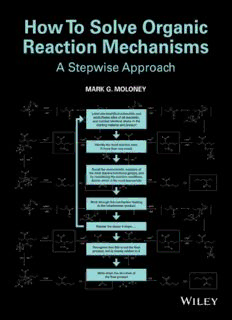
How to solve organic reaction mechanisms : a stepwise approach PDF
Preview How to solve organic reaction mechanisms : a stepwise approach
How to Solve Organic Reaction Mechanisms How to Solve Organic Reaction Mechanisms A Stepwise Approach MARK G. MOLONEY Fellow and Tutor in Chemistry at St Peter’s College and Professor of Chemistry, University of Oxford, UK This edition first published 2015 © 2015 John Wiley & Sons, Ltd Registered office John Wiley & Sons, Ltd, The Atrium, Southern Gate, Chichester, West Sussex, PO19 8SQ, United Kingdom For details of our global editorial offices, for customer services and for information about how to apply for permission to reuse the copyright material in this book please see our website at www.wiley.com. The right of the author to be identified as the author of this work has been asserted in accordance with the Copyright, Designs and Patents Act 1988. All rights reserved. No part of this publication may be reproduced, stored in a retrieval system, or transmitted, in any form or by any means, electronic, mechanical, photocopying, recording or otherwise, except as permitted by the UK Copyright, Designs and Patents Act 1988, without the prior permission of the publisher. Wiley also publishes its books in a variety of electronic formats. Some content that appears in print may not be available in electronic books. Designations used by companies to distinguish their products are often claimed as trademarks. All brand names and product names used in this book are trade names, service marks, trademarks or registered trademarks of their respective owners. The publisher is not associated with any product or vendor mentioned in this book. Limit of Liability/Disclaimer of Warranty: While the publisher and author have used their best efforts in preparing this book, they make no representations or warranties with respect to the accuracy or completeness of the contents of this book and specifically disclaim any implied warranties of merchantability or fitness for a particular purpose. It is sold on the understanding that the publisher is not engaged in rendering professional services and neither the publisher nor the author shall be liable for damages arising herefrom. If professional advice or other expert assistance is required, the services of a competent professional should be sought The advice and strategies contained herein may not be suitable for every situation. In view of ongoing research, equipment modifications, changes in governmental regulations, and the constant flow of information relating to the use of experimental reagents, equipment, and devices, the reader is urged to review and evaluate the information provided in the package insert or instructions for each chemical, piece of equipment, reagent, or device for, among other things, any changes in the instructions or indication of usage and for added warnings and precautions. The fact that an organization or Website is referred to in this work as a citation and/or a potential source of further information does not mean that the author or the publisher endorses the information the organization or Website may provide or recommendations it may make. Further, readers should be aware that Internet Websites listed in this work may have changed or disappeared between when this work was written and when it is read. No warranty may be created or extended by any promotional statements for this work. Neither the publisher nor the author shall be liable for any damages arising herefrom. Library of Congress Cataloging-in-Publication Data Moloney, Mark G. How to solve organic reaction mechanisms : a stepwise approach / Mark G. Moloney. pages cm Originally published as: Reaction mechanisms at a glance (Malden, Mass. : Blackwell Science, 2000). Includes index. ISBN 978-1-118-40159-0 (pbk.) 1. Organic reaction mechanisms. I. Title. QD502.5.M65 2015 547′.2–dc23 2014024070 A catalogue record for this book is available from the British Library. ISBN: 9781118401590 Set in 10/12pt Helvetica Condensed by SPi Publisher Services, Pondicherry, India 1 2015 Contents Preface vi Abbreviations vii About the companion website viii Introduction ix 1 Nucleophilic substitution and elimination 1 2 Alkene and alkyne chemistry 32 3 Nucleophilic additions to carbonyl groups 64 4 Enolate chemistry 96 5 Aromatic chemistry 128 6 Rearrangements 160 7 Ligand coupling processes 192 Index 224 v Preface This book is an upgraded version of Reaction Mechanisms at a Glance, first published in 2000. That book was an attempt to demonstrate that there is indeed an underlying set of rules suitable to working out plausible reaction mechanisms in organic chemistry and which can be grasped with a little effort. More importantly, the use of these rules in a systematic fashion substantially reduces the burden on memory! This version has an expanded set of fully worked problems and a new chapter which applies the problem-solving strategy to ligand-coupling reactions using transition metals. The latter is an addition which represents the exceptional growth and importance of this chemistry, and its widespread application in diverse areas of chemical science. I would like to dedicate this book to my wife Julie and all the members of my family. Mark Moloney 2014 vi Abbreviations Ac Acetyl (CHC(O)-) 3 cat. catalytic Δ Heat DMF N,N-Dimethylformamide (MeNCHO) 2 MCPBA meta-chloroperbenzoic acid PPA Polyphosphoric acid THF Tetrahydrofuran p-TsCl p-Toluenesulfonyl chloride (p-MeCHSOCl) 6 4 2 p-TsOH p-Toluenesulfonic acid (p-MeCHSOH) 6 4 3 py Pyridine (CHN) 5 5 EWG Electron withdrawing group dil. dilute conc. concentrated vii About the companion website This book is accompanied by a companion website: www.wiley.com/go/moloney/mechanisms The website includes worked supplementary questions. viii
Description: